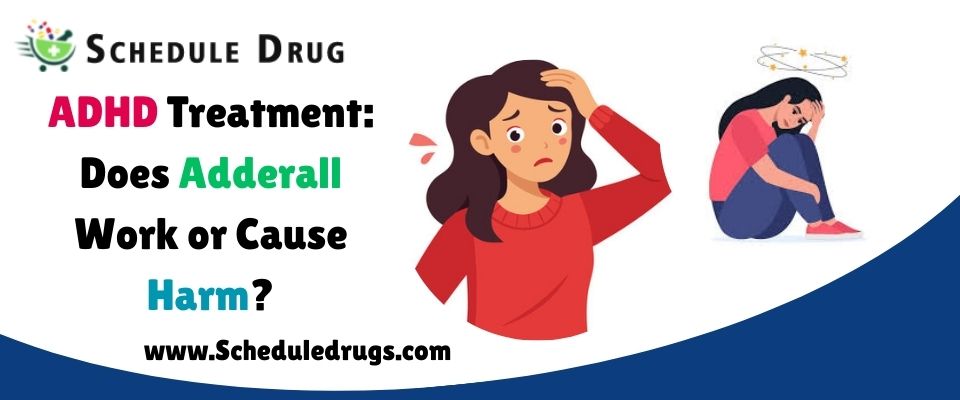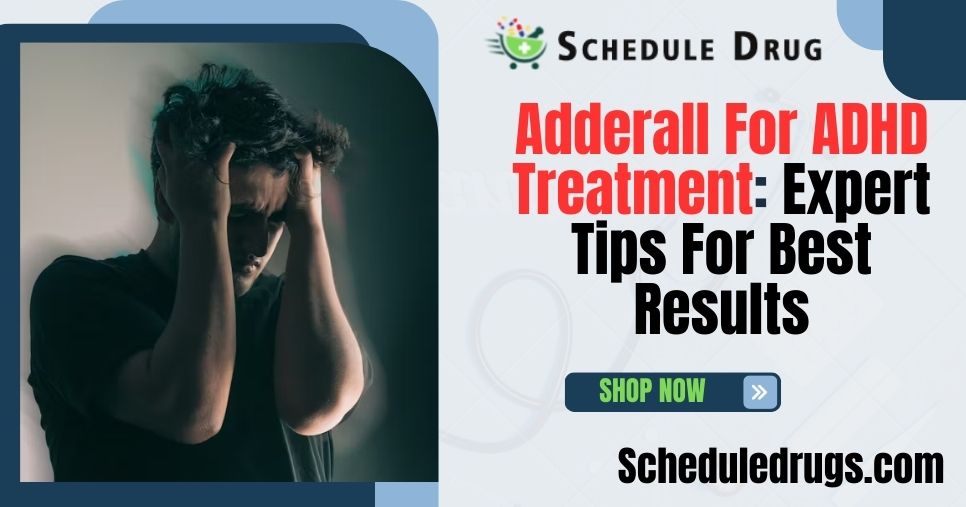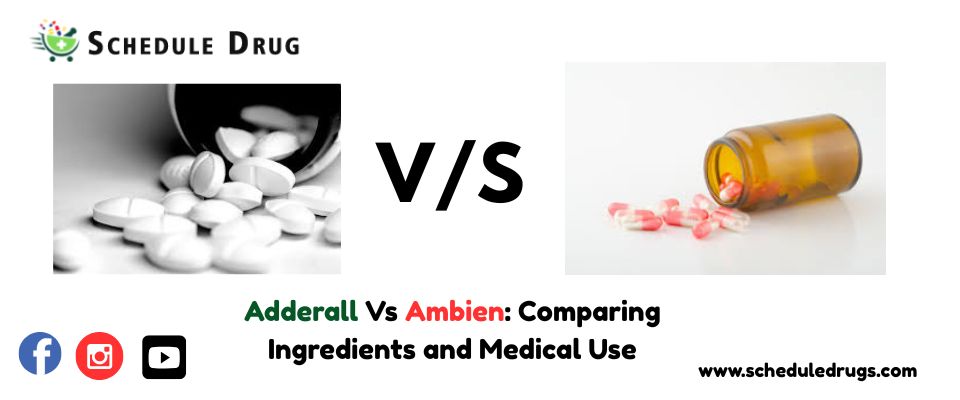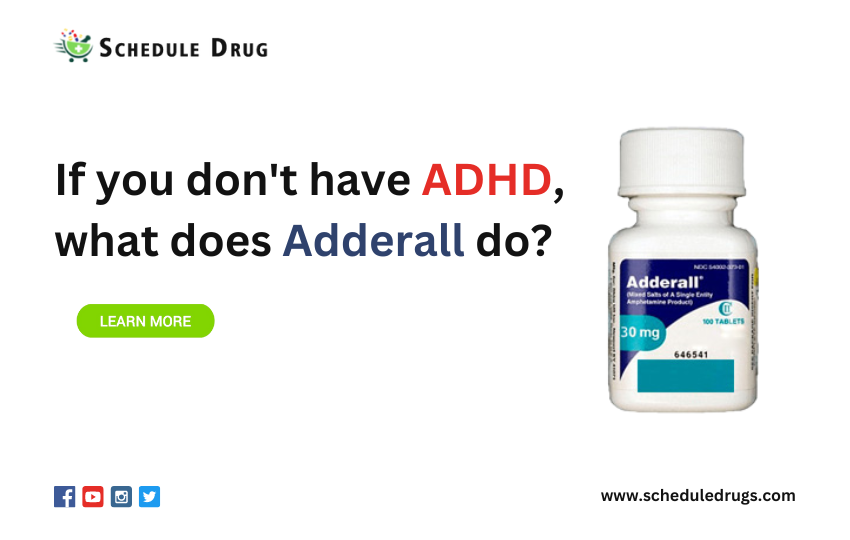ADHD Treatment: Does Adderall Work or Cause Harm?
What is Adderall?
Adderall is a prescription medication commonly used to manage ADHD (Attention Deficit Hyperactivity Disorder) in both children and adults. It belongs to the stimulant medication class, which helps increase focus, attention, and self-control by affecting brain chemicals like dopamine and norepinephrine. People often use Buy Adderall Online to improve concentration and reduce impulsive behaviors. Alternative terms you might see include amphetamine medication or ADHD stimulant.
How Adderall Works in the Brain
Adderall works by stimulating specific neurotransmitters in the brain, which helps improve mental clarity and attention span. This is why it is considered one of the most effective ADHD treatments available. It can be taken in short-acting or long-acting forms, depending on the individual’s needs and lifestyle. Some people also refer to it as a focus-enhancing medication because of its ability to improve concentration.
Who Can Take Adderall?
Adderall is prescribed primarily for individuals diagnosed with ADHD or narcolepsy. However, it should only be used under medical supervision due to potential side effects and risks. Doctors consider factors like age, coexisting conditions, and symptom severity before recommending it. In some cases, it may be compared with other ADHD medications to determine the best option for managing symptoms safely and effectively.
What Is Adderall Used For?
Adderall is primarily prescribed to manage ADHD symptoms in children, adolescents, and adults. It may also be used to treat narcolepsy, a sleep disorder that causes excessive daytime sleepiness. In ADHD, Adderall helps improve concentration, reduce impulsivity, and enhance overall executive functioning.
What is ADHD Medication?
ADHD medication refers to prescription drugs designed to help manage the symptoms of Attention Deficit Hyperactivity Disorder, a condition that affects focus, impulse control, and activity levels. These medications work by balancing brain chemicals such as dopamine and norepinephrine, improving concentration and reducing hyperactive behavior. Also called ADHD treatments or stimulant and non-stimulant therapies, these medications are often part of a comprehensive care plan including therapy and lifestyle strategies.
How ADHD Medications Work
ADHD medications fall into two main categories: stimulants and non-stimulants. Stimulant drugs, like Adderall and Ritalin, increase the activity of neurotransmitters that help the brain maintain focus and control impulses. Non-stimulant medications, such as Strattera or Intuniv, work differently by regulating brain pathways that influence attention and behavior without the same risk of dependency. Both types aim to improve daily functioning, academic performance, and emotional regulation for children and adults.
Choosing the Right ADHD Medication
Selecting the appropriate ADHD medication depends on factors like age, symptom severity, coexisting conditions, and how the body responds to treatment. Healthcare providers may start with a low dose and adjust gradually to balance effectiveness and minimize side effects. Alternative phrases like ADHD drug options, ADHD therapy, or ADHD treatment plans are commonly used when discussing safe and personalized strategies. With proper guidance, ADHD medications can significantly enhance quality of life for both children and adults.
What Are the Different Types of ADHD Medications?
- Stimulants – Such as amphetamines (Adderall, Vyvanse) and methylphenidate (Ritalin, Concerta).
- Non-stimulants – Such as atomoxetine (Strattera) or guanfacine (Intuniv). Non-stimulants are often prescribed when stimulants are ineffective or cause intolerable side effects.
Common ADHD Medication Names
Some widely used ADHD medications include Adderall, Vyvanse, Ritalin, Concerta, Focalin, Strattera, and Intuniv.
ADHD medications are designed to help manage attention, focus, and impulse control in both children and adults. Some of the most commonly prescribed drugs include Adderall, Ritalin, and Vyvanse, which are widely recognized for their effectiveness in controlling ADHD symptoms. These medications are often referred to as stimulant treatments or central nervous system stimulants, and they work by increasing levels of key neurotransmitters in the brain.
Non-Stimulant ADHD Options
Not all ADHD medications are stimulants. Non-stimulant treatments, such as Strattera (atomoxetine) and Intuniv (guanfacine), are also commonly used, especially for individuals who cannot tolerate stimulant side effects. These alternatives are sometimes called behavioral medications or attention-regulating drugs, and they provide symptom relief without the same risk of dependency that stimulants may carry.
Choosing the Right Medication
Selecting the right ADHD medication depends on factors like age, symptom severity, and any coexisting conditions, such as anxiety. While stimulant ADHD medications are often first-line therapy, non-stimulant options can be equally effective for certain patients. Always consult a healthcare provider to find the best ADHD treatment plan tailored to individual needs, ensuring safety and optimal symptom management.
Common Adderall Side Effects
Adderall, a widely prescribed stimulant for ADHD, can improve focus and attention, but it may also cause several side effects. Users often experience insomnia, decreased appetite, and dry mouth, which are among the most frequently reported issues. Other effects can include headaches, irritability, and elevated heart rate, especially when starting treatment or adjusting the dose. Being aware of these potential side effects helps users manage them effectively and communicate concerns with their healthcare provider.
Adderall Side Effects in Adults and Children
The impact of Adderall can differ between adults and children. In children, common effects include loss of appetite, trouble sleeping, and mood swings, while adults may experience increased anxiety, jitteriness, or high blood pressure. Knowing how side effects vary by age and health status allows families and patients to monitor symptoms closely and adjust treatment plans safely.
Managing Risks and Monitoring Effects
While Adderall is effective for treating ADHD symptoms, understanding its risks and adverse reactions is essential. Regular check-ins with a healthcare provider can help minimize side effects and ensure proper dosing. Alternatives or supportive strategies, such as non-stimulant ADHD medications or behavioral therapy, can also be considered if side effects become problematic, helping patients maintain both safety and effectiveness in managing ADHD.
- Insomnia or trouble sleeping – Difficulty falling or staying asleep is common.
- Loss of appetite – Can lead to weight loss or nutritional concerns.
- Dry mouth – Often accompanied by thirst or discomfort.
- Headaches – Mild to moderate headaches may occur, especially initially.
- Increased heart rate – Can cause palpitations or elevated blood pressure.
- Irritability or mood swings – Emotional changes may appear in some users.
- Anxiety or nervousness – May worsen pre-existing anxiety in some patients.
- Nausea or stomach upset – Digestive issues like upset stomach or abdominal pain.
- Dizziness or lightheadedness – Occasionally reported, particularly when standing up quickly.
- Tics or repetitive movements – Rare, but possible in sensitive individuals.
Adderall Side Effects in Different Populations
- Children: Appetite suppression, sleep difficulties, irritability.
- Adults: Anxiety, jitteriness, elevated blood pressure, potential heart complications.
- Elderly or preexisting conditions: Higher risk for cardiovascular problems.
Adderall Dosages
| Age Group | Formulation | Typical Starting Dose | Maximum Daily Dose | Notes |
| Children 3–5 yrs | Adderall IR | 2.5 mg once daily | 10 mg/day | Start low, monitor side effects closely |
| Children 6–12 yrs | Adderall IR | 5 mg once or twice daily | 40 mg/day | Divide doses 4–6 hours apart |
| Children 6–12 yrs | Adderall XR | 5–10 mg once daily | 30 mg/day | Long-acting for once-daily dosing |
| Adolescents 13–17 yrs | Adderall IR | 5 mg once or twice daily | 40 mg/day | Adjust gradually based on response |
| Adolescents 13–17 yrs | Adderall XR | 10 mg once daily | 30 mg/day | Take in the morning to avoid insomnia |
| Adults 18+ yrs | Adderall IR | 5 mg 1–2 times daily | 40 mg/day | Split doses for optimal effect |
| Adults 18+ yrs | Adderall XR | 10 mg once daily | 30 mg/day | Can be taken in the morning, lasts up to 12 hours |
Notes:
- Dosing must be individualized; physicians adjust based on symptom control, side effects, and health conditions.
- Start with the lowest effective dose and increase gradually.
- Monitor for heart rate, blood pressure, appetite changes, and sleep disturbances.
I can also make a more detailed chart including weight-based dosing, adult vs child ranges, and comparison with other ADHD medications for a complete reference table.
Adderall Risks & Warnings
- Risk of Dependence and Abuse:
Adderall is a stimulant and can be habit-forming if used improperly or without medical supervision. Misuse may lead to addiction. - Cardiovascular Risks:
May increase heart rate and blood pressure. People with heart conditions, high blood pressure, or a history of heart problems should use caution. - Mental Health Concerns:
Can worsen anxiety, agitation, or cause mood swings. Rarely, it may trigger manic episodes in individuals with bipolar disorder. - Sleep Disturbances:
Insomnia or trouble falling asleep is common, especially if the medication is taken late in the day. - Appetite and Weight Changes:
Decreased appetite and potential weight loss can occur, particularly in children. - Gastrointestinal Issues:
Some users experience nausea, stomach pain, or dry mouth. - Interactions with Other Medications:
Adderall can interact with certain antidepressants, blood pressure medications, and other stimulants, increasing side effect risks. - Pregnancy and Nursing Warnings:
Use during pregnancy or breastfeeding should be discussed with a healthcare provider due to potential risks to the baby. - Monitoring Required:
Regular medical check-ups are recommended to track blood pressure, heart rate, and mental health while on Adderall.
How Do Stimulant Medications Treat ADHD?
Stimulant medications are often the first-line treatment for ADHD because they help improve focus, attention, and impulse control in both children and adults. These medications, sometimes called ADHD stimulants or brain stimulants, work by increasing levels of key neurotransmitters, such as dopamine and norepinephrine, in the brain. This chemical boost enhances communication between brain regions that control attention, planning, and self-regulation.
Stimulants like Adderall, Ritalin, and Vyvanse are designed to manage ADHD symptoms effectively. They can reduce hyperactivity, improve concentration, and make daily tasks more manageable. Alternative terms such as central nervous system stimulants or ADHD prescription stimulants are often used in medical literature to describe the same class of medications. These drugs act quickly, usually within 30–60 minutes, and their effects can last from a few hours to all day, depending on whether they are short-acting or long-acting formulations.
How Do Nonstimulants Work to Treat ADHD?
Nonstimulant medications provide an effective alternative for managing ADHD symptoms without the stimulant effects that some people find uncomfortable. Unlike traditional stimulant treatments, nonstimulants work by regulating neurotransmitters in the brain, such as norepinephrine, to improve focus, attention, and impulse control. They are often recommended for individuals who cannot tolerate stimulants or have coexisting conditions like anxiety or heart problems.
The Benefits of Nonstimulant ADHD Medications
Nonstimulant ADHD treatments, sometimes called non-stimulant therapy or non-stimulant options, offer a slower but steady improvement in concentration and behavior. They carry a lower risk of dependency and can be taken alongside other medications if needed. Common nonstimulant options include atomoxetine (Strattera) and guanfacine (Intuniv), which help regulate brain chemicals to reduce hyperactivity and impulsive behavior.
Who Should Consider Nonstimulant Options?
Nonstimulants may be ideal for children, teens, or adults who experience side effects from stimulant ADHD medications, such as insomnia, jitteriness, or increased heart rate. Healthcare providers often choose nonstimulant therapy when long-term management is needed, or if the patient has additional conditions like anxiety or substance use concerns. By targeting ADHD symptoms without causing the intense stimulation of amphetamines, these medications can improve daily functioning while minimizing risks.
How is ADHD Medication Dosed?
ADHD medication dosing is personalized to each individual to ensure safety and effectiveness. The amount of medicine prescribed depends on factors such as age, weight, symptom severity, and coexisting health conditions. Doctors typically start with a low dose and gradually adjust it to find the optimal balance between symptom control and side effects.
Factors Influencing ADHD Medication Dosage
Several factors influence the right dosage of ADHD treatments, including whether the medication is a stimulant (like Adderall or Ritalin) or a non-stimulant (such as Strattera or Intuniv). Other considerations include a patient’s tolerance, lifestyle, and daily schedule. By carefully monitoring these factors, healthcare providers aim to maximize focus, attention, and behavioral control while minimizing side effects.
Monitoring and Adjusting Dosage Over Time
ADHD medication dosing is not fixed and often requires regular check-ins with a healthcare professional. Adjustments may be needed if side effects appear, symptoms change, or new health concerns arise. Parents, adults, and caregivers are encouraged to track improvements and challenges to help doctors fine-tune the treatment plan for the best results.
Which ADHD Medication is Best for My Child?
Choosing the right ADHD medication for your child can feel overwhelming, but understanding the options helps make informed decisions. The “best” medication depends on your child’s age, symptom severity, coexisting conditions, and how they respond to treatment. Both stimulant and non-stimulant medications are effective for managing inattention, hyperactivity, and impulsivity.
Stimulants vs Non-Stimulants
Stimulant medications, such as Adderall or Ritalin, are often the first choice because they are highly effective in improving focus and reducing hyperactive behavior. Non-stimulant treatments, like Strattera or Intuniv, may be recommended if your child experiences side effects or has conditions like anxiety or heart issues. Each type works differently in the brain, so your healthcare provider will help determine which is safer and more effective for your child.
Factors to Consider When Choosing ADHD Medication
When deciding which ADHD medication is right for your child, consider dosage options, how long the medication lasts (short-acting vs long-acting), potential side effects, and your child’s daily routine. Monitoring your child’s response and adjusting the treatment plan over time ensures the best results. Always consult a qualified pediatrician or psychiatrist before making changes to medication.
Short-acting and Long-acting Options
Amphetamines: Adderall (short-acting), Adderall XR (long-acting), Vyvanse (long-acting)
Methylphenidates: Ritalin (short-acting), Concerta (long-acting), Focalin XR (long-acting)
ADHD medications come in both short-acting and long-acting formulations to meet different daily schedules and symptom needs. Short-acting stimulants, like immediate-release Adderall or Ritalin, work quickly and usually last 4–6 hours. They are ideal for situations where temporary focus and attention are needed, such as during school or work hours. These medications may require multiple doses throughout the day to maintain consistent symptom control.
Benefits of Long-acting Options
Long-acting or extended-release ADHD medications—including Adderall XR, Concerta, and Vyvanse—are designed to provide steady symptom relief for up to 12 hours. They reduce the need for multiple doses and help maintain focus throughout the school or workday. For adults and children with busy schedules, long-acting medications can improve adherence, consistency, and overall productivity.
Choosing Between Short-acting and Long-acting ADHD Medications
Selecting the right option depends on lifestyle, daily routine, and symptom patterns. Some individuals benefit from the flexibility of short-acting medications, while others prefer the convenience and consistent effect of long-acting formulations. Consulting with a healthcare professional is essential to tailor ADHD treatment for optimal focus, attention, and safety.
Additional Common Questions
1. Can ADHD medications cause weight loss?
Yes, stimulant ADHD medications like Adderall or Ritalin can suppress appetite, which may lead to weight loss over time. Non-stimulant medications are less likely to affect weight. Monitoring diet and nutrition while on treatment is important.
2. How long do stimulant effects last?
Short-acting stimulants generally last 4–6 hours, while long-acting or extended-release formulations can work 8–12 hours. Duration depends on the specific medication, dose, and individual metabolism.
3. Can adults take ADHD medication safely?
Yes, adults can safely use ADHD medications under medical supervision. Healthcare providers consider coexisting conditions, such as anxiety or heart problems, and may adjust dosing accordingly.
4. What should I do if side effects appear?
If you experience side effects such as insomnia, anxiety, or elevated heart rate, contact your doctor immediately. Adjusting the dose, switching formulations, or considering non-stimulant options can help manage side effects safely.
5. Can ADHD medications affect sleep?
Stimulants may cause insomnia or disrupted sleep, especially if taken later in the day. Long-acting medications taken in the morning or adjusting timing can reduce sleep disturbances.
6. Are ADHD medications addictive?
Stimulant medications carry a risk of dependence if misused. When taken as prescribed, the risk is low. Non-stimulant options like atomoxetine have little to no abuse potential.
7. Can ADHD medications help with focus at work or school?
Yes, both short-acting and long-acting ADHD medications improve attention, concentration, and task completion. Long-acting options are ideal for full-day coverage in school or workplace settings.
8. How do I know which ADHD medication is right for me?
The best ADHD medication depends on age, symptom severity, coexisting conditions, and lifestyle. Doctors often start with low doses and may try different options to find the most effective treatment with minimal side effects.



